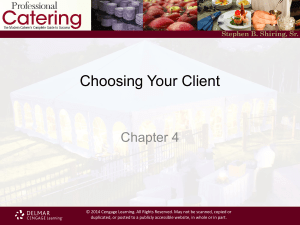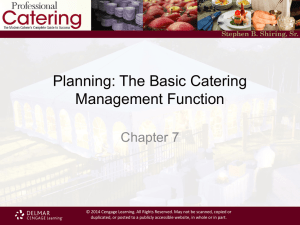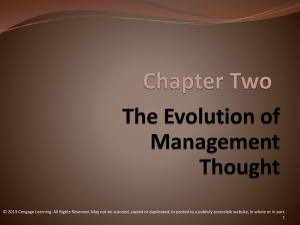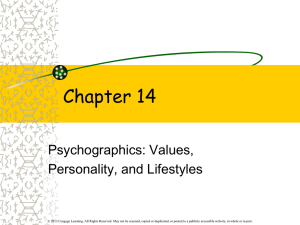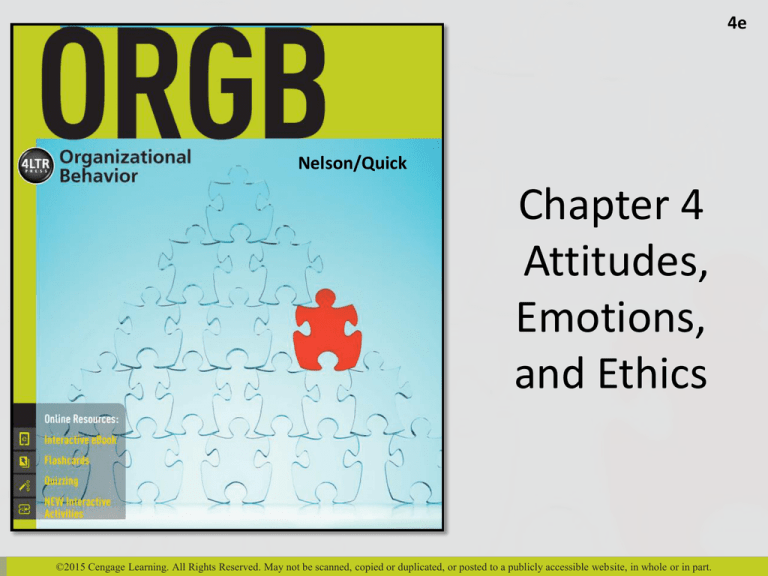
4e
Nelson/Quick
Chapter 4
Attitudes,
Emotions,
and Ethics
©2015 Cengage Learning. All Rights Reserved. May not be scanned, copied or duplicated, or posted to a publicly accessible website, in whole or in part.
Learning Outcomes
Explain the ABC model of an attitude
Describe how attitudes are formed
Identify sources of job satisfaction and commitment
Distinguish between organizational citizenship and
workplace deviance behaviors
Identify the characteristics of the source, target, and
message that affect persuasion
©2015 Cengage Learning. All Rights Reserved. May not be scanned, copied or duplicated, or posted to a publicly accessible website, in whole or in part.
2
Learning Outcomes
Discuss the definition and importance of emotions
at work
Contrast the effects of individual and organizational
influences on ethical behavior
Identify the factors that affect ethical behavior
©2015 Cengage Learning. All Rights Reserved. May not be scanned, copied or duplicated, or posted to a publicly accessible website, in whole or in part.
3
Table 4.1 - The ABC Model of an
Attitude
Adapted from M. J. Rosenberg and C. I. Hovland, “Cognitive, Affective, and Behavioral Components of Attitude,” in M. J. Rosenberg, C. I. Hovland,
W. J. McGuire, R. P. Abelson, and J. H. Brehm, eds., Attitude Organization and Change (New Haven, Conn.: Yale University Press, 1960). Copyright
1960 Yale University Press. Used with permission.
©2015 Cengage Learning. All Rights Reserved. May not be scanned, copied or duplicated, or posted to a publicly accessible website, in whole or in part.
4
Two Influences on Attitude
Formation
Direct experience - Results in attitudes that are:
Stronger, held more confidently, and more resistant
to change
Active in one’s cognitive processes
Social learning: Deriving attitudes from family, peer
groups, religious organizations, and culture
Modeling - Individuals acquire attitudes by observing
others
©2015 Cengage Learning. All Rights Reserved. May not be scanned, copied or duplicated, or posted to a publicly accessible website, in whole or in part.
5
Job (Dis) Satisfaction
Job satisfaction: Pleasurable or positive emotional
state resulting from the appraisal of one’s job
Affected by the job characteristics
Contributing factors
Challenging work, valued rewards, and opportunities
for advancement
Competent supervision and supportive coworkers
Job Descriptive Index (JDI)
Measures the specific facets of satisfaction
©2015 Cengage Learning. All Rights Reserved. May not be scanned, copied or duplicated, or posted to a publicly accessible website, in whole or in part.
6
Work Attitudes
Organizational citizenship
behavior (OCB)
Workplace deviance
behavior (WDB)
• Behavior that is above and
beyond the call of duty
• Satisfied workers are more
likely to engage in OCBs
• Leads to lower turnover
and higher productivity at
the organizational level
• Any voluntary
counterproductive
behavior that violates
organizational norms and
adversely affects
organizational functioning
• Negative events that occur
in an organization trigger
WDB
©2015 Cengage Learning. All Rights Reserved. May not be scanned, copied or duplicated, or posted to a publicly accessible website, in whole or in part.
7
Figure 4.2 - The Elaboration
Likelihood Model of Persuasion
SOURCE: Adapted from R. E. Petty and J. T. Cacioppo, “The Elaboration Likelihood Model of Persuasion,” in L. Berkowitz, ed., Advances in Experimental Social
Psychology, vol. 19 (New York: Academic Press, 1986), 123–205.
©2015 Cengage Learning. All Rights Reserved. May not be scanned, copied or duplicated, or posted to a publicly accessible website, in whole or in part.
8
Emotions and Moods
Emotions
• Mental states that include
Moods
• Classified as positive or
feelings, physiological
negative and made up of
changes, and the inclination
various emotions
to act
• Short-lived, intense reactions
• Last longer than emotions
• Do not have a specific cause
to an event
• Have a specific, known cause
• Impact both work attitudes
and work behaviors
©2015 Cengage Learning. All Rights Reserved. May not be scanned, copied or duplicated, or posted to a publicly accessible website, in whole or in part.
9
Ethical Behavior
Acting in ways consistent with one’s personal values
and the commonly held values of the organization
and society
Effects
Firms with good reputations attract more job
applicants
Firms can experience lower returns and slow sales
growth for up to five years as a result of illegal
corporate behavior
©2015 Cengage Learning. All Rights Reserved. May not be scanned, copied or duplicated, or posted to a publicly accessible website, in whole or in part.
10
Figure 4.3 - Individual/Organizational
Model of Ethical Behavior
©2015 Cengage Learning. All Rights Reserved. May not be scanned, copied or duplicated, or posted to a publicly accessible website, in whole or in part.
11
Values
Enduring beliefs that a specific mode of conduct is
personally or socially preferable to an opposite
mode of conduct
Instrumental values: Shape acceptable behaviors
that can be used to achieve some goal or end state
Terminal values: Influence the goals to be achieved
or the end states of existence
©2015 Cengage Learning. All Rights Reserved. May not be scanned, copied or duplicated, or posted to a publicly accessible website, in whole or in part.
12
Locus of Control
Internal
Belief in personal control and personal responsibility
Resistant to social pressure
External - Belief in control by outside forces
Fate, chance, other people
©2015 Cengage Learning. All Rights Reserved. May not be scanned, copied or duplicated, or posted to a publicly accessible website, in whole or in part.
13
Machiavellianism
Personality characteristic involving one’s willingness
to do whatever it takes to get one’s own way
High-Machs
Low-Machs
• Deceitful and have a cynical
view of human nature
• Do not care for
conventional notions of
right and wrong
• Skilled manipulators
• Value loyalty and
relationships
• Less willing to manipulate
others for personal gain
• Are concerned with others’
opinions
©2015 Cengage Learning. All Rights Reserved. May not be scanned, copied or duplicated, or posted to a publicly accessible website, in whole or in part.
14
Figure 4.4 - Kohlberg’s Stages of
Cognitive Moral Development
©2015 Cengage Learning. All Rights Reserved. May not be scanned, copied or duplicated, or posted to a publicly accessible website, in whole or in part.
15




